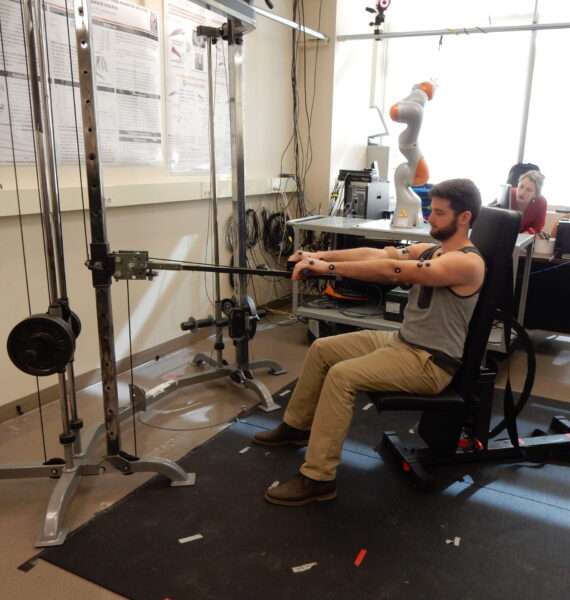Research
| The goal of the Movement Biomechanics Lab (MoBL) is to evaluate and improve clinical outcomes for rehabilitation of upper limb function by combining computational and experimental approaches.
We use principles of mechanics, dynamics, and control; computational simulation; and subject-specific analyses based on muscle imaging, strength and functional assessments to compare treatment options and predict outcomes, identify the most critical biomechanical and physiologic factors associated with improved function, and provide a foundation for clinical practitioners to optimize rehabilitation for their patients. Some of our recent projects are detailed below. Please visit the Publications page for more details about our work. Our musculoskeletal models and simulation tools are also available for download. |
 Lab Equipment Demonstration
|
Projects
|
Upper limb computational modeling and simulation
 We develop high fidelity computational biomechanical models incorporating mathematical representations of upper limb anatomy, muscle force-generating capacity, intersegmental dynamics, and neuromuscular control as a platform for studying the effects of neuromuscular and orthopaedic injury, predicting outcomes of orthopaedic surgical interventions, and understanding healthy and impaired motor control.
|
|
Detailed characterization of muscle structure and function
 We acquire detailed in vivo experimental measures of upper limb muscle architecture, intramuscular fat, strength, and function in a variety of healthy and impaired populations, including changes with age, rotator cuff injury, peripheral nerve injury, and spinal cord injury. We acquire detailed in vivo experimental measures of upper limb muscle architecture, intramuscular fat, strength, and function in a variety of healthy and impaired populations, including changes with age, rotator cuff injury, peripheral nerve injury, and spinal cord injury. |
|
Bone-muscle interactions following brachial plexus birth injury
 Traumatic neurological injury to the brachial plexus (BPI) results in paralysis of upper limb muscles. When BPI occurs at birth, permanent postural (e.g. internal rotation contracture) and osseous (e.g. glenoid malformation) deformities may result in the developing shoulder. We explore interactions between altered muscle structure and bone growth as a foundation for understanding the progression of deformity in these patients.
|
|
Neuromuscular coordination of upper limb function
 Complex coordination of upper limb muscles is required to actuate the upper limb and maintain shoulder stability at the glenohumeral joint. Understanding functional behavior throughout the reachable workspace, during daily tasks, or for maximal performance can provide insight to the demands on the neuromuscular system, muscle and joint loading, and task requirements. Coordination can be disrupted following nerumuscular or orthopaedic injury, leading to compensations and altered loading that may increase risk for future injury.
|
|
Neuromechanics of exoskeleton-assisted gait
 People with locomotor impairments can experience significantly higher walking costs and lower preferred walking speeds, and may experience overuse injuries and/or osteoarthritis from compensatory increased joint loading, especially in the low back and knee. Exoskeleton assistance has the potential to reduce walking cost but may alter user neuromechanics, muscle, and joint loading. We seek to improve understanding of user response and the influence of device design on the biomechanics of locomotion.
|
|
Mechanics of rotator cuff injury
 Atrophied, retracted, and stiff muscle–tendon units are technically challenging to manipulate and perform poorly after surgical repair. Our work employs computational and experimental approaches to explore interplay of tendon stiffness and intraoperative tension, as a foundation for understanding poor repair outcomes and providing guidance for clinical practice. Post-injury, we explore muscle architecture, intramuscular fat, and task performance to understand muscle compensations and altered joint loading. |
|
Surgical simulation
 We use surgical simulation to understand biomechanical consequences of a variety of orthopaedic surgeries designed to restore upper limb function, including following peripheral nerve injury, spinal cord injury, and fracture. Example procedures include tendon transfers, nerve transfers, and rotator cuff repair. |